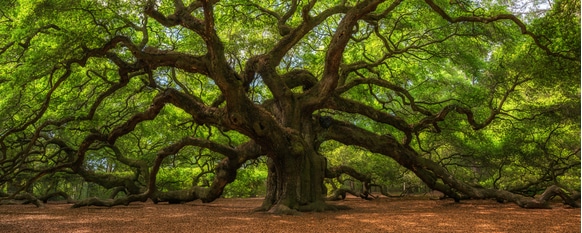Sturdy, majestic, and long-lived easily describe oak trees. It has a timeless beauty and has many appealing characteristics.
If you’re considering adding an oak tree to your landscape’s family of plants, we cover all the important details here on the Green Pinky. Keep reading to learn how to take care of them, some popular oak varieties, and design ideas.
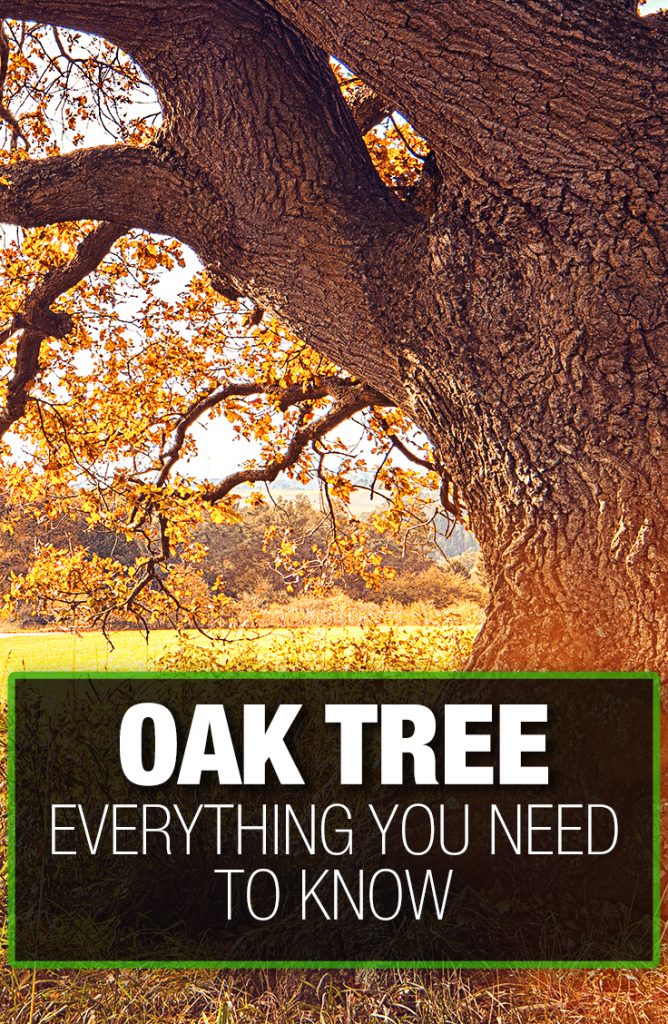
General Information
Oak trees belong in the family Fagaceae and in the genus Quercus. They have incredibly long lifespans, with many living over 1000 years.
The genus is quite large, containing around 600 different species of trees and shrubs. North America claims the largest amount of different species. The United States alone claims over 90 different types native to the area.
Some of the species are deciduous, while others are evergreen and retain their leaves year-round. Many deciduous types add a blast of brilliant color to winter landscapes.
All oaks have enormous trunks, branches, and showy bark. Some have branches that seem to curve and weave through an area, eventually touching the ground with age.
The most notable feature is their acorns. Depending on the species, the acorns may differ in size and shape, but all of them have cup-like caps.
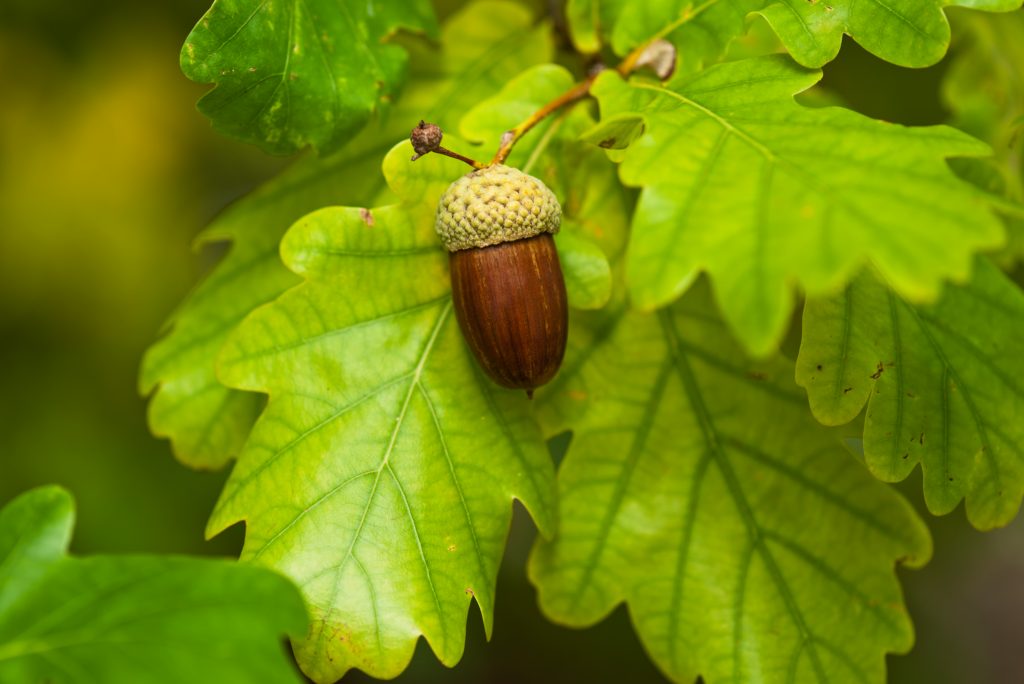
Care Guide
With so many different oaks to choose from, it’s crucial to select one hardy in your climate. Appropriate soil conditions and the size of the proposed space are also important considerations. Some prefer wet conditions and others thrive in dry. Also, some species require acidic soil – they won’t tolerate alkaline conditions.
Make sure to keep reading below for some of the common species that you can consider growing.
Site Considerations
Since many develop into large trees, choose a variety that will fit in the proposed space. You want it to be able to reach its mature size without interference. Therefore, don’t plant close to any structures or under power lines.
It’s important to select a permanent site. Regardless of species, all oak trees don’t like their roots disturbed. They don’t transplant well.
In fact, we recommend that you avoid planting in location where cars might park under its canopy. While the shade may seem like a good idea, you don’t want to roots encroaching onto the road.
You also don’t want to use pavers or concrete under them. They don’t thrive with compacted soil.
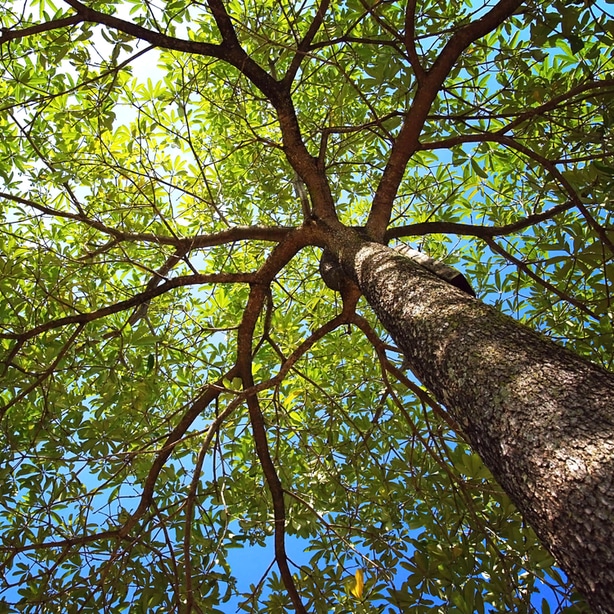
Soil Considerations
It’s important to know your site’s soil conditions. You can almost guarantee health problems if you plant an oak tree that requires a dry site in a wet location. You’ll also want to check whether the species you have prefers acidic or alkaline soil.
Before planting, you may want to consider sending your soil into a local testing lab to have an accurate analysis of the contents of your soil.
Design Ideas
The vast majority of species make an impressive and imposing presence in the landscape. They are well-suited for homes with large yards. Oaks mature into large, stately trees with extremely wide canopies. Because of how big they can become, large species may visually overpower a small yard.
Those with smaller yard spaces that don’t accommodate a large tree can grow shrubby varieties. Scrub oaks (Quercus berberidifolia) grow 15 feet tall and wide. This evergreen shrub is hardy in USDA zones 6 to 10.
Need to beat the summer heat? Oaks make dense and robust shade trees. Depending on the variety, they can give deep to filtered shade.
They also make great additions to native, woodland, or wildlife gardens. The canopy offers shelter to various wildlife species. Falling acorns are a good food source for many animals.
They even make a stately presence utilized around water features like ponds. Just be sure to use a species that doesn’t mind wet feet.
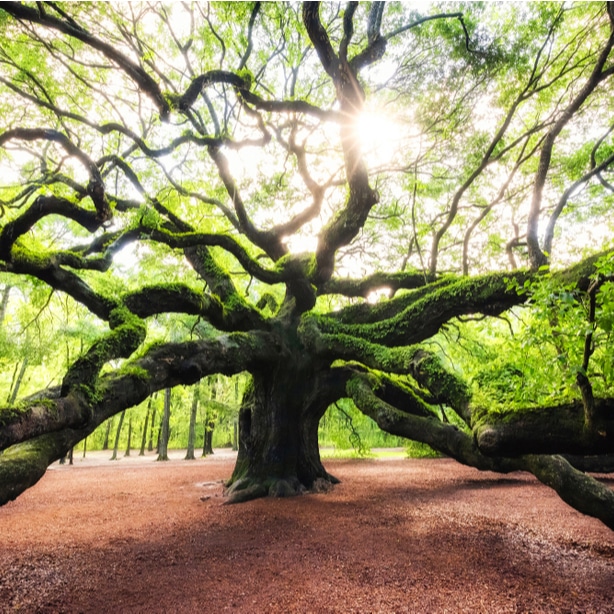
Common Varieties
Below are a list of some of the most common varieties and their characteristics are listed below:
White Oak (Quercus alba)
These trees grow up to 80 tall and wide at a slow to moderate rate of speed. They are hardy in USDA zones 6 to 9. It is native from Florida to Maine and westward to Texas.
It has a deciduous habit producing red fall leaves. A mature white oak develops a showy rounded crown with massive branches. It’s typically wider than it is tall.
They grow best in a sunny to a partially sunny location. They also favor deep, acidic soil kept moist through regular water applications.
Scarlet Oak (Quercus coccinea)
These trees earn their name from the color that their leaves change into in the fall. It is hardy when grown in USDA zones 6 to 9.
The Scarlet has a deciduous habit. Mature trees grow around 70 feet tall with a width of 50 feet. It produces a tall open crown filled with glossy green leaves and has a grayish-brown, scaly bark. They produce a deep root systems.
For the best performance, grow scarlet oaks in a sunny location. The tree prefers deep, acidic soils that are well-drained. They have moderate tolerance to drought.
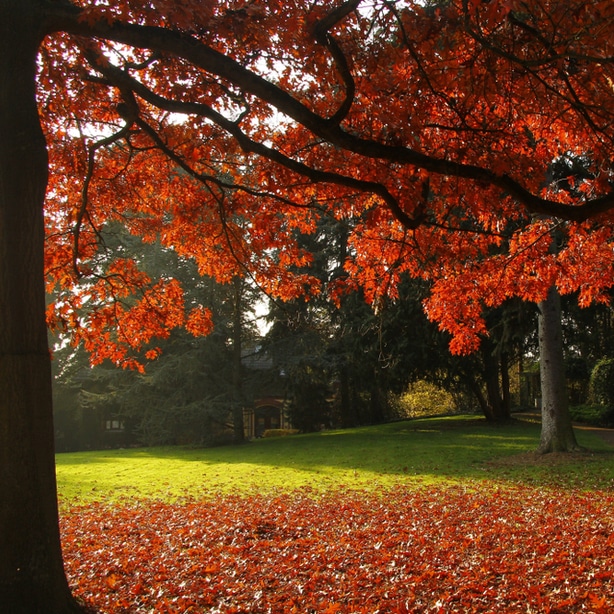
Bur Oak (Quercus marcocarpa)
These trees also go by the common name mossycup due to the large acorns that are held in mossy cups. They are hardy growing in USDA zones 3 to 8.
The tree has a deciduous habit. It forms into a large tree, reaching around 80 feet tall and wide at maturity. They produce rounded and open crowns filled with glossy green leaves with white undersides. In the fall, the leaves become yellow.
For the best performance, grow them trees in full sun. It prefers soils that drain well but tolerates a wide range of soil conditions. Bur oaks have a high tolerance for drought conditions.
Willow Oak (Quercus phellos)
This variety grows into medium to large trees. It matures to a height of 40 to 75 feet with a spread of up to 50 feet. It is hardy growing in USDA zones 5 to 9.
Willows have a deciduous habit. Trees produce a rounded canopy filled with bright green leaves. Leaves have showy fall colors, changing to hues of yellow and red before dropping. Of all the different species, willow oaks sport the most delicate foliage.
The bark on immature trees is smooth. However, as it matures, it becomes grayish-brown with shallow furrows.
They perform well in sunny to partially shady locations. They tolerate a wide range of acidic soil conditions from dry to those with poor drainage.
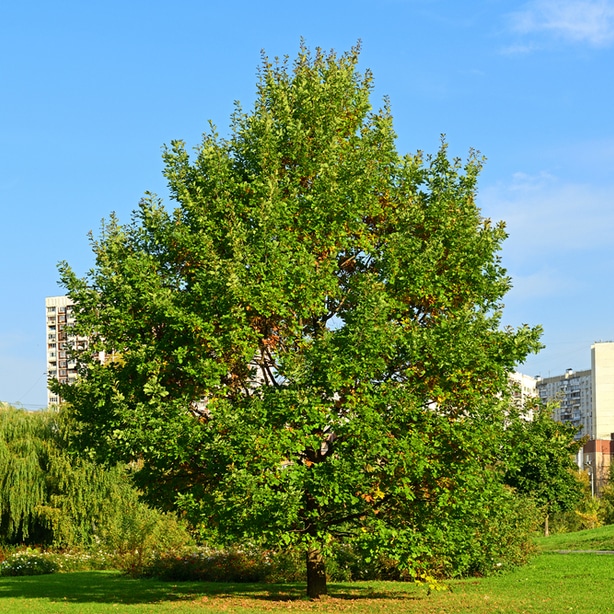
English Oak (Quercus robur)
Native to Europe, this variety made its way to North American in the 1600s. It is hardy growing in USDA zones 6 to 8.
This majestic tree has a deciduous habit. They form rounded canopies that are broad and spreading. The canopies fills with 3-inch dark green leaves that are greenish-blue on their undersides.
English oaks have shorter trunks with black to gray bark. The bark has deep furrows.
For the best growth, they prefer a site located in full sun. Although adaptable to a wide range of different soil conditions, it prefers a site with well-drained soil.
Red Oak (Quercus rubra)
This species earns its name from its red foliage in the spring and in the fall. It is hardy in USDA zones 6 to 8.
The fast-growing tree matures to a height and width of around 75 feet. It produces a round canopy with broad, spreading branches. The deciduous tree’s canopy fills with dark green leaves that are greenish-gray on their undersides.
For the best performance, grow them in full sun. They require acidic soils that are loose and drain well.
Live Oak (Quercus virginiana)
A signature tree representing the Old South, this species is a majestic, long-lived trees make a statement. It is is hardy growing in USDA zones 8 to 10.
They are typically wider than tall. They grow to be around 80 feet tall with a width of about 100 feet. Live oaks are best suited for larger landscapes due to their massive size.
They are evergreen and develop rounded canopies with low-hanging branches. The tree’s canopy fills with leathery, dark green leaves. The leaves are whitish on their undersides.
Grow live oak trees in a sunny location for the best growth. Although they adapt to a wide range of soil conditions, fertile soils that are well-drained and deep are best.
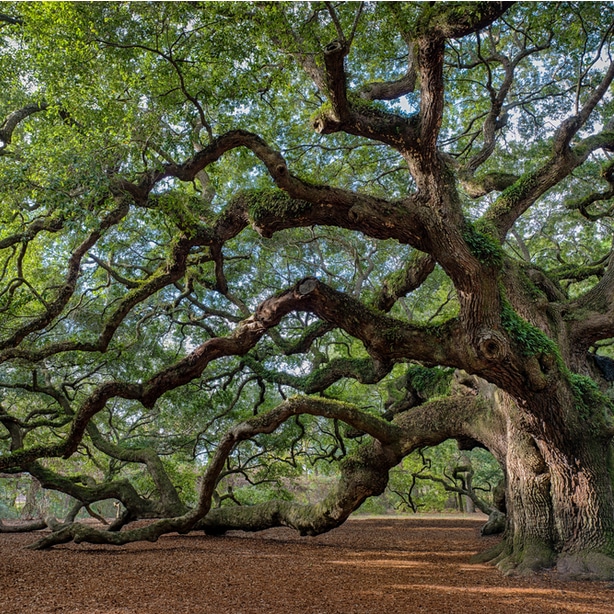
Chinkapin Oak (Quercus muehlenbergii)
These trees earned their name because their foliage resemble the foliage of a chestnut tree. The chestnuts are referred to as chinquapins and thus the common name. They are hardy in USDA zones 5 to 7.
The North American native forms into a medium-sized tree. Its mature size is typically around 40 to 60 feet tall and wide.
Chinkapin oaks form a rounded canopy filled with lush, glossy green, toothed leaves that grow up to 7 inches long. Adding to the tree’s good looks and lush foliage is the light-colored bark.
It has a high drought-tolerance, tolerating a wide range of soils from dry to rocky. That being said, fertile and loamy soils produce the best growth. Grow it in a sunny location.
Water Oak (Quercus nigra)
As the name suggests, this variety tolerates growing in wet conditions. This deciduous native tree is found growing along riverbanks and streams. It are hardy growing in USDA zones 6 to 9.
Also going by the common name possum oak, the large native has a conical form. Mature trees quickly grow up to 80 feet tall and 60 feet wide.
The tree forms a dense, rounded canopy filled with 4-inch, bluish-green leaves that are deciduous.
For the the most robust growth, grow it in a sunny location. It prefers well-drained, acidic soils.
Pin Oak (Quercus palustris)
This variety earns its common name from its tough, short branchlets that are located on its branches and limbs. The fast-growing, deciduous native is hardy in USDA zones 4 to 8.
It has a pyramidal-shaped crown densely covered in glossy dark green leaves. Lower branches tend to dip towards the ground.
These trees bring fabulous fall colors with the foliage changing to shades of red and bronze.
Grow pin oaks in a sunny location. They grow well in acidic soils that are moist to wet. They also tolerates sites that occasionally flood.
Uses of Oaks
Despite their many uses in landscape designs, they have been useful for a variety of things throughout human history.
Its wood is hard, dense and strong. As such, they are commonly used in construction. Furthremore, because its wood contains a high amount of tannin, it is resistant to insects and fungi attacks.
In fact, in the 9th and 10th centuries, Viking longships were manufactured from oak planking. In the Middle Ages, fine furniture and interior paneling were also made from it. Nowadays, wood from the red oak is used for lumber. The wood is also in barrels for aging spirits like sherry, wine, and whiskey.
If you’ve ever smoked food, you might have flavored it with small oak chips. Their wood chips are typically used commercially to smoke and add flavor to various cheeses, meats, and fish.

Companion Plants
Some plants grow better under and around oaks than others do. If you’re adding something, just be sure it tolerates the same growing conditions. You don’t want to plant something that requires a lot of fertilizer and water if your oak likes things on the dry side. Keep plants about 10 feet away from the trunk.
Groundcovers
Companion groundcovers include:
- California Aster (Corethrogyne filaginifolia) – Yellow daisy-like flowers in summer.
- Hummingbird Sage (Salvia spathacea) – Magenta flower spikes in summer.
- Yarrow (Achillea millifollum) – Small white flowers in late spring and summer.
- Dwarf Plumbago (Ceratostigma plumbaginoides) – Blue flowers most of the year.
Shrubs
Some examples of companion shrubs include:
- Rock Rose (Cistus ‘Sunset’) – Bright pink blooms in late summer.
- Wild Lilac (Ceanothus thyrsiflorus) – Fragrant, light blue flower spikes in spring.
- Coffeeberry (Rhamnus californica) – Resemble oak trees with attractive berries.
- Butterfly bush (Buddleia davidii) – Fragrant flower spikes in spring and summer.

Perennials
Perennial plants that are good companion plants include:
- Red Hot Poker (Kniphofia uvaria) – Tall red and yellow flower stalks in summer.
- Forget-Me-Not (Myosotis sylvatica) – Blue flowers in spring.
- Mexican Sage (Salvia leucantha) – Purple flower spikes in summer.
- Society Garlic (Tulbaghia violacea) – Lavender flowers and foliage smells like onions.
Annuals
Annuals that make good companion plants include:
- Bachelors’ Button (Centaurea cyanus) – Blue or white flowers in summer.
- Garden Nasturtium (Tropaeolum majus) – Funnel-shaped, edible flowers in various hues.
- Pincushion Flower (Scabiosa atropurpurea) – Purple, pink or white summer blooms.
- California Poppy (Eschscholzia californica) – Orange flowers in spring and summer.

